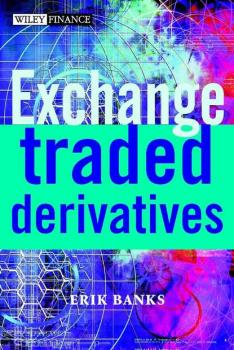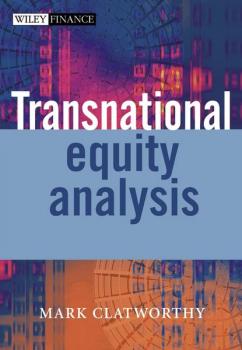ТОП просматриваемых книг сайта:
Группа авторов
Список книг автора Группа авторовАннотация
Exchange-Traded Derivatives provides an overview of the global listed futures and options markets, and how individual exchanges and products are adapting to a new operating environment – an environment characterized by rapid, almost continuous, change. This book serves as an ideal resource on the 21st century listed derivative markets, products and instruments. Divided into three parts, Exchange-Traded Derivatives begins by providing an overall understanding of the marketplace and the forces that have, and are, altering the operating environment – stressing how exchanges need to change in order to cope with the challenges. The author then provides a comprehensive description of leading established exchanges, detailing their origins and structure, range of products and services, strengths and 'weaknesses'. The book concludes with a look at emerging marketplaces – those in developing countries as well as new «electronic» platforms – that are likely to increase in importance over the coming years. Exchange-Traded Derivatives is a valuable reference for fund managers, corporate treasurers, corporate risk managers, CFOs and those seeking a detailed guide to the world's derivative exchanges and products.
Аннотация
In-depth answers for professionals looking to accurately value foreign equities Transnational Equity Analysis is today's most thorough guide to its subject, examining and comparing the techniques used by top analysts and fund managers in the analysis of domestic and overseas equities. The book outlines the effects of international differences in disclosure and measurement rules and practices, examines how investors and analysts have discovered coping mechanisms for using fundamental analysis in an international context, and more. Mark Clatworthy (Cardiff, Wales) is a lecturer in the Cardiff Business School, UK.
Аннотация
A practical approach to ART-an alternative method by which companies take on various types of risk This comprehensive book shows readers what ART is, how it can be used to mitigate risk, and how certain instruments/structures associated with ART should be implemented. Through numerous examples and case studies, readers will learn what actually works and what doesn't when using this technique. Erik Banks (CT) joined XL Capital's weather/energy risk management subsidiary, Element Re, as a Partner and Chief Risk Officer in 2001.
Аннотация
Over recent years there has been rapid consumer-led growth in investing in socially responsible companies to the extent that it has had an influence on corporate policies. New regulations recognise the public interest by requiring all pension funds to declare their ethical policy. Investors can no longer just consider the financial aspects of a company before investing but also have to consider the complex world of ethical investments. Should the ethical policy take precedence over the financial aspects? Should policies be inclusive or exclusive? What percentage of a company's income has to come from unacceptable sources before the source is excluded? Should any exclusion policy also extend to those involved in selling or transporting goods deemed unacceptable? This is the first book to look at socially responsible investment from the perspective of the institutional investor, who will be led through the complex dilemmas of socially responsible investment with practical examples and advice.
Аннотация
Trading Regime Analysis is a groundbreaking work on how markets behave and how to profit from this behaviour. The book describes that it is the human nature of markets which explains why this behaviour exists and whether one believes in fundamental or technical market analysis, the ebb and flow of volatility is the one undeniable truth that exists in financial and commodity markets. It is the up and down cycles of volatility that is the manifestation of human psychology as the ultimate driver of markets and volatility, like human behaviour, has a distinct cycle to it. Offers in detail the methods that can be used to identify whether a market is about to start trending or about to enter a period of range trading Highlights important applications for this analysis for institutional investors, asset allocators, hedge fund managers and retail investors Provides unique content as there are no existing titles on trading regime analysis
Аннотация
This book shows traders how to use Intermarket Analysis to forecast future equity, index and commodity price movements. It introduces custom indicators and Intermarket based systems using basic mathematical and statistical principles to help traders develop and design Intermarket trading systems appropriate for long term, intermediate, short term and day trading. The metastock code for all systems is included and the testing method is described thoroughly. All systems are back tested using at least 200 bars of historical data and compared using various profitability and drawdown metrics.
Аннотация
Accounting for Derivatives: Advanced Hedging under IFRS is a comprehensive practical guide to hedge accounting. This book is neither written by auditors afraid of providing opinions on strategies for which accounting rules are not clear, nor by accounting professors lacking practical experience. Instead, it is based on day-to-day experience, advising corporate CFOs and treasurers on sophisticated hedging strategies. It covers the most frequent hedging strategies and addresses the most pressing challenges that corporate executives find today. The book is case-driven with each case analysing in detail a real-life hedging strategy. A broad range of hedging strategies have been included, some of them using sophisticated derivatives. The objective of this book is to provide a conceptual framework based on the extensive use of cases so that readers can create their own accounting interpretation of the hedging strategy being considered. Accounting for Derivatives will be essential reading for CFOs, internal auditors and treasurers of corporations, professional accountants as well as derivatives professionals working at commercial and investment banks. Key feature include: The only book to cover IAS39 from the derivatives practitioner’s perspective Extensive real-life case studies to providing essential information for the practitioner Covers hedging instruments such as forwards, swaps, cross-currency swaps, and combinations of standard options as well as more complex derivatives such as knock-in forwards, KIKO forwards, range accruals and swaps in arrears. Includes the latest information on FX hedging and hedging of commodities
Аннотация
In many companies credit management is a passive and reactive discipline. This results in significant receivables assets weighing heavily on balance sheets, dragging down cash flow and inhibiting growth. The power of credit is shackled, muted. Release the power and passion of credit management in your company. Proactively squeeze every morsel of value out of receivables and simultaneously, protect your company from the bad debt danger that lurks in the value chain. Harness the power of credit to effectively manage your company's receivables. Immediately make a positive difference in your company, and use this book as a resource for years to come. Reading Global Credit Management will help you wake the sleeping giant on your balance sheet make receivables earn their keep, just like every other asset. wrest control of credit from bureaucratic processes, grab it by the throat and wring out every drop of value. And last but by no means least, boost the value of your company. «…one of the most intelligent and refreshing exposés of the present and future role of international credit management that I have read in a long time. Global Credit Management represents a very welcome and innovative addition to the small library of quality publications available on international credit and risk management.» —Tim Lane, Director of European Operations, Finance, Credit and International Business (FCIB)
Аннотация
In Volatility and Correlation 2nd edition: The Perfect Hedger and the Fox, Rebonato looks at derivatives pricing from the angle of volatility and correlation. With both practical and theoretical applications, this is a thorough update of the highly successful Volatility & Correlation – with over 80% new or fully reworked material and is a must have both for practitioners and for students. The new and updated material includes a critical examination of the ‘perfect-replication’ approach to derivatives pricing, with special attention given to exotic options; a thorough analysis of the role of quadratic variation in derivatives pricing and hedging; a discussion of the informational efficiency of markets in commonly-used calibration and hedging practices. Treatment of new models including Variance Gamma, displaced diffusion, stochastic volatility for interest-rate smiles and equity/FX options. The book is split into four parts. Part I deals with a Black world without smiles, sets out the author’s ‘philosophical’ approach and covers deterministic volatility. Part II looks at smiles in equity and FX worlds. It begins with a review of relevant empirical information about smiles, and provides coverage of local-stochastic-volatility, general-stochastic-volatility, jump-diffusion and Variance-Gamma processes. Part II concludes with an important chapter that discusses if and to what extent one can dispense with an explicit specification of a model, and can directly prescribe the dynamics of the smile surface. Part III focusses on interest rates when the volatility is deterministic. Part IV extends this setting in order to account for smiles in a financially motivated and computationally tractable manner. In this final part the author deals with CEV processes, with diffusive stochastic volatility and with Markov-chain processes. Praise for the First Edition: “In this book, Dr Rebonato brings his penetrating eye to bear on option pricing and hedging.… The book is a must-read for those who already know the basics of options and are looking for an edge in applying the more sophisticated approaches that have recently been developed.” —Professor Ian Cooper, London Business School “Volatility and correlation are at the very core of all option pricing and hedging. In this book, Riccardo Rebonato presents the subject in his characteristically elegant and simple fashion…A rare combination of intellectual insight and practical common sense.” —Anthony Neuberger, London Business School
Аннотация
At the height of the 1990s boom, Jack Grubman, one of the most successful analysts in Wall Street proclaimed ‘what used to be conflicts of interest are now synergies’. This myopia contributed dramatically to the elevation of a culture in which greed was deified, oversight denigrated and misfeasance justified. Since the fall of the markets and the implosion of confidence in the American corporate business model, one man has proved instrumental in deconstructing the rhetoric of the 1990s: Eliot Spitzer, the combative Attorney General of New York. In the process, his innovative application of state law has reconfigured the governance of Wall Street. Over the past three years the pursuit of transparency and accountability in the structure of the markets has propelled Spitzer to the forefront of regulatory policy. His investigations into tainted analyst research, the mutual funds industry, the governance of the New York Stock Exchange and the insurance industry have focused attention not just on corrupted individuals but also the complicity of the financial structure itself. Spitzer exploited the inherent conflicts of interest to the full, forcing regulators to adopt a much more proactive approach and creating a national platform for his own wider political ambitions. Now holding the Democratic nomination for the Governorship of New York, Spitzer has begun a path for higher national office. This groundbreaking book features exclusive access with many of the key actors in these changes to the governance of Wall Street. It examines how Eliot Spitzer exploited gaps in the regulatory framework to capture the corporate reform agenda and explores the implications of his actions on policy formation and recalibration. Key incidents include: changing the terms of reference governing analyst research; the defenestration of Dick Grasso’s tenure over the NYSE (which is now being heard in state court in New York); and the battles for control between the former Chairman of the Securities Exchange Commission, Harvey Pitt, and Spitzer. The book details not only the contested, contingent and interdependent connections between the American political and financial systems but reveals how Spitzer’s manipulation of those connections have proved instrumental in enhancing his own wider political ambitions.










